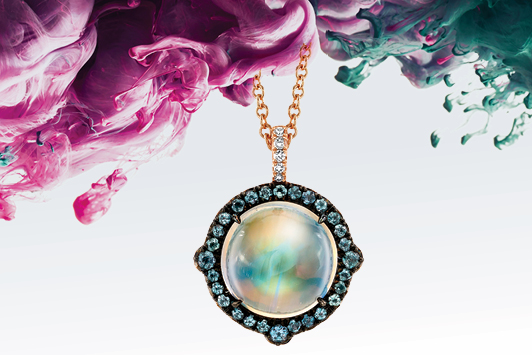
When Parlé Gems purchased a large parcel of peach- to pink-hued Lotus garnet in 2016, it whetted the brand’s appetite for an underdog gem that has become a specialty.
“We expanded our garnet offering to include purple, mint, spessartine, tsavorite and rhodolite,” says Brecken Farnsworth, the Idaho-based jeweler’s creative director.
Garnet was one of several lower-profile gems that gave tried-and-true ones like rubies, emeralds, sapphires and opals a run for their money at the recent Las Vegas trade fairs. Along with more abundant gems such as moonstone and spinel, garnet is rising to superstar status thanks to its intense color, durability, and good pricing compared to rarer stones.
The American Gem Trade Association (AGTA) GemFair was a prime spot for showcasing these specimens and others, as were the new Premier show, the Las Vegas Antique Jewelry & Watch Show, and JCK’s Global Gemstone Neighborhood.
Trio of champions
Why are garnets so popular? They “have bold, saturated colors and are durable and affordable compared to other gems,” explains gemologist and industry consultant Ben Guttery.
These hardy stones include green demantoids from Russia and Namibia, tsavorite from Kenya and Tanzania, and “the most amazing deep saturated purple garnets from eastern Africa and India,” according to Gary Roskin, CEO of the International Colored Gemstone Association (ICA).
Then there’s spinel, which has become highly collectible. From red to pink to blue (especially cobalt blue) to grey, spinel is selling. Rising prices for gems like ruby have made spinel more attractive in cost and appearance.
Gemstone dealer Robert Bentley noticed grey spinel at a number of AGTA booths, and his own had an ample inventory of it from the Mogok region of Burma. Available sizes ranged from 1.50 to 5 carats, in light grey colors to dark saturated ones full of fire.
“This gravitas of look, accessible price points of $300 to $1,200 triple keystone [three times the price the seller paid], and eight on the hardness scale make spinel a formidable gemstone,” he says.
Moonstones are also moving. This milky-hued, greyish rock is arguably one of the most popular gems today. Wide demand for neutral colors helps fuel this love affair. Sailesh Lakhi of AGTA member Sparkles & Colors USA saw robust demand for his bluish, Indian-origin material, which was fine and clean but has been getting harder to find in bigger sizes. Simon Watt of gem dealer Mayer & Watt sold myriad rainbow numbers from Madagascar at the AGTA fair, particularly “included ones in fancy shapes that were so funky,” he says.
At the super-high end, jeweler Omi Privé — which also has a loose-stone division — sold out of a specific moonstone and aquamarine style on day one of the JCK Luxury show. “We had four reorders for it,” reports company president Niveet Nagpal.
Who’s responsible
Also receiving attention at the fairs were a number of pressing gemological issues.
Disclosure of enhancements was the top concern among interviewees. The first line of defense in this case is simply to ask vendors about treatments. The second, though, is “affordable and consistently accurate laboratory reports, [which] help to give confidence to the trade and the consumer,” says Roskin.
For AGTA vendors, disclosure is a given thanks to the organization’s long-established Code of Ethics and Fair Business Practices. This allows shoppers to “buy with confidence of full disclosure from AGTA members,” notes David Baker, the trade body’s membership and education manager.
Social responsibility, including mine-to-market transparency, was another hot topic. Many AGTA members already buy directly from artisanal miners with the aim of positively impacting their communities — for example, Columbia Gem House’s longtime Fair Trade stone purchases in Africa, and sapphire importer Sheahan Stephen’s work with Sri Lankan miners. ICA members, too, are passionate about helping mining communities.
“We are doing our best to care for the welfare of the artisanal and small-scale mining (ASM) community, the cutting industry, and the environment,” says the ICA’s Roskin about members’ efforts. “With 95% of the gemstone-mining community being part of the ASM, our first and foremost priority is to make certain of the health and welfare of those who provide us with the gems we cherish.”
Origin stories
Stateside mining sources are another rich storyline. AGTA-member mines in Arkansas, Nevada, Colorado, Montana, and Washington state are responsible for increased production and supply, especially for “sapphire, jade, sunstone, optical quartz, and turquoise,” says Baker.
Knowing stone origins goes hand in hand with many industry efforts and is a point of salability. From perches at the Sands Expo, Greenland Ruby shared the story of its pinkish-red, single-origin gems, while designer Victoria Tse of VTse highlighted a bracelet with mint-colored, cabochon-cut chrysoprase mined in Greenland as well.
Lakhi understands the importance of origin. While dealers 20 years ago emphasized some origins, it wasn’t nearly as crucial as it is today. Russian alexandrite, for example, commands a premium over Brazilian and Sri Lankan material. And now Lakhi can’t sell a non-calibrated, unheated ruby or sapphire without a certificate.
A case in point was a clean, oval-shaped, 5-carat ruby he had in Las Vegas that teetered between two vastly different price points: a higher sum if the origin was Burma, and a bit less if it was Vietnam. A tie-breaking report from a lab was supposed to have the final say, but it was inconclusive. “Now we’re getting a fourth report, as it’s indispensable [for concluding] origin,” says Lakhi.
Image: Omi Privé/ShutterstockArticle from the Rapaport Magazine - July 2019. To subscribe click here.